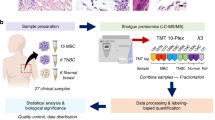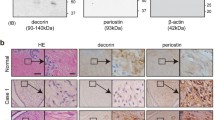Abstract
The aim of this study is to evaluate tropomyosin-4 (TM4) expression in infiltrating ductal breast carcinomas (IDCAs), as well as its prognostic significance. Using a 2-DE/MALDI-TOF mass spectrometry investigation coupled with an immunohistochemical approach, we have assessed the expression of TM4 in IDCAs, as well as in other types of breast tumors. Proteomic analyses revealed an increased expression of tropomyosin-4 in IDCA tumors. Using immunohistochemistry, overexpression of tropomyosin-4 was confirmed in 51 additional tumor specimens. Statistical analyses revealed, however, no significant correlations between tropomyosin-4 expression and clinicopathological parameters of the disease including tumor stage, patient age, estrogen and progesterone receptor status, and lymph node metastasis occurrence. A significant association was found, however, with a high Scarf–Bloom–Richardson (SBR) grade, a known marker of tumor severity. Additionally, the SBR component showing a correlation with TM4 expression was the tubular differentiation status. This study demonstrates the upregulation of tropomyosin-4 in IDCA tissues, which may highlight its involvement in breast cancer development. Our findings also support a link between tropomyosin-4 expression and aggressiveness of IDCA tumors.



Similar content being viewed by others
References
Hill C, Doyon F. Frequency of cancer in France: 2004 update. Bull Cancer. 2004;91:9–14.
Hondermarck H. Breast cancer: when proteomics challenges biological complexity. Mol Cell Proteomics. 2003;2:281–91.
Chung L, Baxter RC. Breast cancer biomarkers: proteomic discovery and translation to clinically relevant assays. Expert Rev Proteomics. 2012;9:599–614.
Tang SS, Gui GP. Biomarkers in the diagnosis of primary and recurrent breast cancer. Biomark Med. 2012;6:567–85.
Qin XJ, Ling BX. Proteomic studies in breast cancer. Oncol Lett. 2012;3:735–43.
Bisca A, D'Ambrosio C, Scaloni A, Puglisi F, Aprile G, Piga A, et al. Proteomic evaluation of core biopsy specimens from breast lesions. Cancer Lett. 2004;204:79–86.
Hondermarck H, Vercoutter-Edouart AS, Révillion F, Lemoine J, el-Yazidi-Belkoura I, Nurcombe V, et al. Proteomics of breast cancer for marker discovery and signal pathway profiling. Proteomics. 2001;1:1216–32.
Imai K, Ichibangase T, Saitoh R, Hoshikawa Y. A proteomics study on human breast cancer cell lines by fluorogenic derivatization-liquid chromatography/tandem mass spectrometry. Biomed Chromatogr. 2008;22:1304–14.
Bergman AC, Benjamin T, Alaiya A, Waltham M, Sakaguchi K, Franzén B, et al. Identification of gel-separated tumor marker proteins by mass spectrometry. Electrophoresis. 2000;21:679–86.
Thomas PA, Kirschmann DA, Cerhan JR, Folberg R, Seftor EA, Sellers TA, et al. Association between keratin and vimentin expression, malignant phenotype, and survival in postmenopausal breast cancer patients. Clin Cancer Res. 1999;5:2698–703.
Kanaujiya JK, Lochab S, Kapoor I, Pal P, Datta D, Bhatt ML, et al. Proteomic identification of Profilin1 as a co-repressor of estrogen receptor alpha in MCF7 breast cancer cells. Proteomics. 2013. doi:10.1002/pmic.201200534.
Bradford MM. A rapid and sensitive method for the quantitation of microgram quantities of protein utilizing the principle of protein-dye binding. Anal Biochem. 1976;72:248–54.
O'Farrell PZ, Goodman HM, O'Farrell PH. High resolution two-dimensional electrophoresis of basic as well as acidic proteins. Cell. 1977;12:1133–41.
Gunning P, O'Neill G, Hardeman E. Tropomyosin-based regulation of the actin cytoskeleton in time and space. Physiol Rev. 2008;88:1–35.
O'Neill GM, Stehn J, Gunning PW. Tropomyosins as interpreters of the signaling environment to regulate the local cytoskeleton. Semin Cancer Biol. 2008;18:35–44.
Choi C, Kim D, Kim S, Jeong S, Song E, Helfman DM. From skeletal muscle to cancer: insights learned elucidating the function of tropomyosin. J Struct Biol. 2012;177:63–9.
Lin JJ, Warren KS, Wamboldt DD, Wang T, Lin JL. Tropomyosin isoforms in nonmuscle cells. Int Rev Cytol. 1997;170:1–38.
Chou CC, Davis RC, Fuller ML, Slovin JP, Wong A, Wright J, et al. Gamma-actin: unusual mRNA 3'-untranslated sequence conservation and amino acid substitutions that may be cancer related. Proc Natl Acad Sci USA. 1987;84:2575–9.
Franzén B, Linder S, Alaiya AA, Eriksson E, Fujioka K, Bergman AC, et al. Analysis of polypeptide expression in benign and malignant human breast lesions. Electrophoresis. 1997;18:582–7.
He QY, Cheung YH, Leung SY, Yuen ST, Chu KM, Chiu JF. Diverse proteomic alterations in gastric adenocarcinoma. Proteomics. 2004;4:3276–87.
Pawlak G, Helfman DM. Cytoskeletal changes in cell transformation and tumorigenesis. Curr Opin Genet Dev. 2001;11:41–7.
Bhattacharya B, Prasad GL, Valverius EM, Salomon DS, Cooper HL. Tropomyosins of human mammary epithelial cells: consistent defects of expression in mammary carcinoma cell lines. Cancer Res. 1990;50:2105–12.
Zhu S, Si ML, Wu H, Mo YY. MicroRNA-21 targets the tumor suppressor gene tropomyosin 1 (TPM1). J Biol Chem. 2007;282:14328–36.
Ormsby AH, Goldblum JR, Rice TW, Richter JE, Gramlich TL. The utility of cytokeratin subsets in distinguishing Barrett's-related esophageal adenocarcinoma from gastric adenocarcinoma. Histopathology. 2001;38:307–11.
Li DQ, Wang L, Fei F, Hou YF, Luo JM, Wei-Chen, et al. Identification of breast cancer metastasis-associated proteins in an isogenic tumor metastasis model using two-dimensional gel electrophoresis and liquid chromatography-ion trap-mass spectrometry. Proteomics. 2006;6:3352–68.
Elston CW, Ellis IO. Pathological prognostic factors in breast cancer I. The value of histological grade in breast cancer: experience from a large study with long-term follow-up. Histopathology. 1991;19:403–10.
Abouhamed M, Reichenberg S, Robenek H, Plenz G. Tropomyosine-4 expression is enhanced in differentiating smooth muscle cells in vitro and during atherogenesis. Eur J Cell Biol. 2003;82:473–82.
Qi Y, Chiu JF, Wang L, Kwong DL, He QY. Comparative proteomic analysis of esophageal squamous cell carcinoma. Proteomics. 2005;5:2960–71.
Suehara Y, Kondo T, Fujii K, Hasegawa T, Kawai A, Seki K, et al. Proteomic signatures corresponding to histological classification and grading of soft tissue sarcomas. Proteomics. 2006;6:4402–9.
Katsetos CD, Herman MM, Mörk SJ. Class III beta-tubulin in human development and cancer. Cell Motil Cytoskeleton. 2003;55:77–96.
Mialhe A, Lafanechère L, Treilleux I, Peloux N, Dumontet C, Brémond A, et al. Tubulin detyrosination is a frequent occurrence in breast cancers of poor prognosis. Cancer Res. 2001;61:5024–7.
Kuroda H, Ishida F, Nakai M, Ohnisi K, Itoyama S. Basal cytokeratin expression in relation to biological factors in breast cancer. Hum Pathol. 2008;39:1744–50.
Zheng Q, Safina A, Bakin AV. Role of high-molecular weight tropomyosins in TGF-beta-mediated control of cell motility. Int J Cancer. 2008;122:78–90.
Landreth GE, Williams LK, Rieser GD. Association of the epidermal growth factor receptor kinase with the detergent-insoluble cytoskeleton of A431 cells. J Cell Biol. 1985;101:1341–50.
Prasad GL. Tropomyosin-1, a novel suppressor of cellular transformation is downregulated by promoter methylation in cancer cells. Cancer Lett. 2002;183:205–13.
Stehn JR, Schevzov G, O'Neill GM, Gunning PW. Specialization of the tropomyosin composition of actin filaments provides new potential targets for chemotherapy. Curr Cancer Drug Targets. 2006;6:245–56.
Novy RE, Lin JL, Lin CS, Lin JJ. Human fibroblast tropomyosin isoforms: characterization of cDNA clones and analysis of tropomyosin isoform expression in human tissues and in normal and transformed cells. Cell Motil Cytoskeleton. 1993;25:267–81.
Matsumura F, Lin JJ, Yamashiro-Matsumura S, Thomas GP, Topp WC. Differential expression of tropomyosin forms in the microfilaments isolated from normal and transformed rat cultured cells. J Biol Chem. 1983;258:13954–64.
Prasad GL, Fuldner RA, Cooper HL. Expression of transduced tropomyosin 1 cDNA suppresses neoplastic growth of cells transformed by the ras oncogene. Proc Natl Acad Sci USA. 1993;90:7039–43.
Franzén B, Linder S, Uryu K, Alaiya AA, Hirano T, Kato H, et al. Expression of tropomyosin isoforms in benign and malignant human breast lesions. Br J Cancer. 1996;73:909–13.
Acknowledgments
This work was supported by le Ministère de l’Enseignement Supérieur et de la Recherche Scientifique, le Ministère de la Santé Publique de la République Tunisienne, and by the Center National de Recherche Scientifique (Strasbourg, France).
Conflicts of interest
None
Author information
Authors and Affiliations
Corresponding author
Rights and permissions
About this article
Cite this article
Kabbage, M., Trimeche, M., ben Nasr, H. et al. Tropomyosin-4 correlates with higher SBR grades and tubular differentiation in infiltrating ductal breast carcinomas: an immunohistochemical and proteomics-based study. Tumor Biol. 34, 3593–3602 (2013). https://doi.org/10.1007/s13277-013-0939-0
Received:
Accepted:
Published:
Issue Date:
DOI: https://doi.org/10.1007/s13277-013-0939-0




